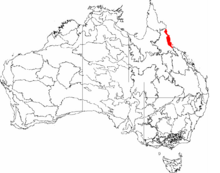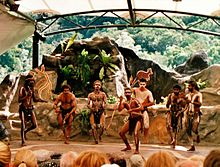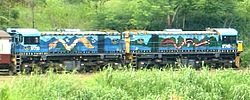Djabugay facts for kids
Quick facts for kids Djabugay people |
|
|---|---|
| Aka: Tjapukai (Tindale), Djabuganjdji (Horton) Jaabugay (AIATSIS), Dyaabugay (SIL) |
|

Wet Tropics Bioregion
|
|

Tjapukai performance in Cairns
|
|
| Hierarchy | |
| Language Family: | Pama–Nyungan |
| Language Branch: | Yidinic |
| Language Group: | Djabugay |
| Group Dialects: |
|
| Area (approx. 800 km²) | |
| BioRegion: | Wet Tropics |
| Location: | Far North Queensland |
| Coordinates: | 16°50′S 145°30′E / 16.833°S 145.500°E |
| Mountains: |
|
| Rivers |
|
| Other Geological: |
|
| Urban Areas |
|
The Djabugay people (also called Djabuganydji or Tjapukai) are a group of Aboriginal people from Australia. They are the first people to live in the mountains, gorges, and forests of a beautiful area in Far North Queensland. This area includes the Barron Gorge and is part of the Wet Tropics of Queensland.
Contents
Djabugay Language
The Djabugay language is part of a larger group called the Pama–Nyungan language family. It belongs to a smaller branch within that family called Yidinic. Djabugay is very similar to the Yidin language.
What makes Djabugay special is that it's one of only three languages in Australia that doesn't have a "dual form." This means it doesn't have a special way to talk about exactly two people or things. The last person who knew the language very well was Gilpin Banning.
Djabugay Country
The Djabugay people's traditional land stretches from south of Mareeba along the Barron River. It goes south to Kuranda and north towards Port Douglas. Their land also reaches west to the edge of the rainforest, from Tolga up to Mount Molloy.
By 1952, the Djabugay people also claimed the coastal area between Cairns Inlet and Lamb Range. One group of Djabugay lived near Redlynch, which is close to Cairns.
Djabugay Stories and Beliefs
The Djabugay word for their ancient stories and creation time is bulurru. This is like the "Dreamtime" or "Story time" for other Aboriginal groups. It's a time from long ago, before anyone alive can remember.
One important story tells of the Rainbow Serpent named Gudju Gudju. He appeared as a giant carpet snake, also known as Budadji. He traveled through the land, trading things with families. He exchanged shells from the coast for rainforest items like dilly bags. As he moved, his body shaped the land, creating places like Yaln giri (Crystal Cascades) and Ngunbay (Kuranda).
Budadji traveled along the Mowbray River to a hill at Port Douglas. He finally rested at Wangal Djungay (Double Island). In one story, emu men killed him at Din din (the Barron Falls). This event is said to have caused the powerful monsoon rains in the area.
There are also stories about two Bulurru brothers, Damarri and Guyala. They created the land's features, made plant foods, and set up the traditional laws. They also established the system of clan marriage. For example, the shapes of the Barron River and Redlynch Valley are seen as the body of Damarri lying down.
The story of Budadji's journey along the Barron Gorge is even shared by Queensland Rail. You can find it in their guide for the train trip from Cairns to Kuranda.
Djabugay History
When European settlers arrived, they explored the land. They also cleared it to find gold and tin. Sadly, there were many violent events where Aboriginal people were killed. These happened at places like Smithfield (in 1878), near the Clohesy River close to Kuranda in the early 1880s, and near Mareeba in 1881.
In May 1886, a railway was built from Cairns to Herberton. Part of this railway was built over a traditional walking track. The Djabugay people were not happy about this. They resisted the settlers by spearing their bullocks and sometimes the settlers themselves. As settlers moved in, they took over the traditional hunting and gathering areas.
This led to a sad event known as the Speewah massacre in 1890. A man named John Atherton took revenge on the Djabugay after a bullock was killed. He sent in native troopers, who were Aboriginal police, to attack the Djabugay.
Later, many Djabugay people were forced to live at the Mona-Mona Mission. There, they could not hunt, fish, or move freely as they used to. Their population dropped a lot around the year 1900.
By 1896, coffee farms were growing in the region. The Djabugay people were used as workers on these farms. Today, many Djabugay people own their own land, and some have settlements and farms in the area.
On December 17, 2004, it was officially recognized that the Djabugay people have native title rights over the land in the Barron Gorge National Park.
Native Title for the Djabugay People
All Djabugay people share a common connection to their ancestors. These ancestors had names from the Djabugay languages and passed down their language, knowledge, traditions, heritage, and laws from one generation to the next.
In 2004, a judge named Justice Jeffrey Spender looked at the Djabugay land claims. He explained that for the Djabugay, the natural features of the land, like mountains and rivers, prove the truth of their bulurru stories and laws. These features are seen as clear evidence of their creation time and the powerful beings from their stories. This means that the physical landscape, with its "storyplaces" and "storywaters," shows the strong and lasting connection between the Djabugay people, their ancestors, and their land.
There was a long disagreement between the Djabugay and the Yirrganydji people over land claims. The Yirrganydji claimed native title to the area from Cairns to Port Douglas. This disagreement became important because of where the Tjapukai Aboriginal Cultural Park was built. Some Djabugay people wanted their claim to be part of a larger Djabugay claim. However, the Yirrganydji insisted on keeping their separate identity. Eventually, the groups representing both peoples reached an agreement.
Notable People


